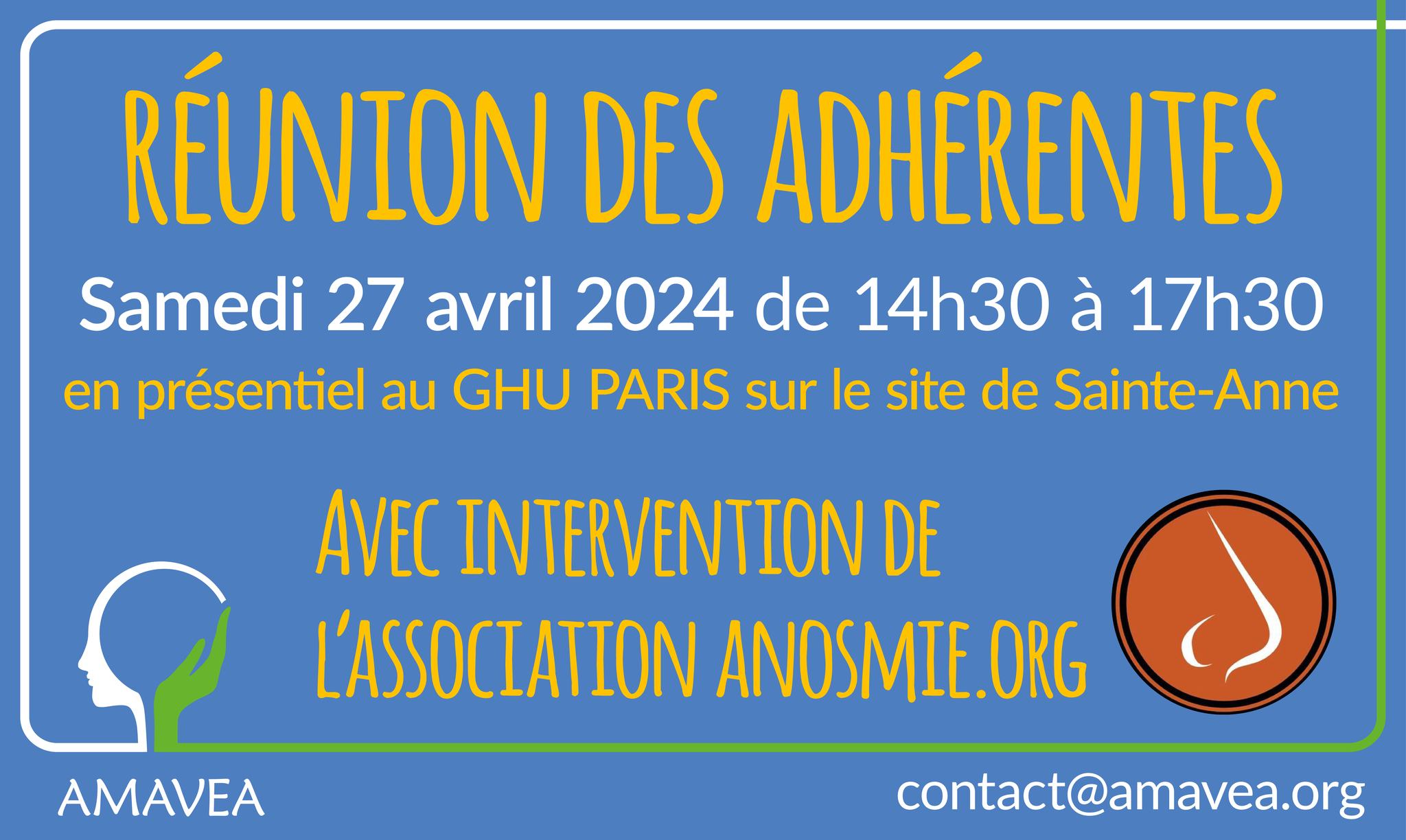Amavea and Anosmia
Conference of April 27, 2024
- Jean-Michel Maillard, founding president Anosmie
- Claire Martin, Olfaction research manager, CNRS Paris
- Magali Guibert, Ile de France regional delegate, Amavea
- Amavea and anosmia members
While we are surrounded by smells permanently, we hardly pay attention. Except when the scent of the scent of our bus neighbor reaches us or the compost bin is full.
By the sensors of the language, we identify the flavors of the food we eat, it is the taste.
Through inspiration, the fragrant molecules enter to the bottom of the nose, the odors, the aromas, it is smell.
Smelling and taste are often associated because very close and complementary, these are two different senses. If the smell is affected, the taste can be too, it is not systematic.
The smell is made up of several mechanical and neural elements that complement each other to send information to the brain.
The detection of smells (eg clementine, pink, cloves) is done in the nose by the olfactory mucosa (in orange on the drawing below). The information then went back to the brain by a structure called 'Olfactory bulb' (in yellow on the drawing below). This detection can be done by 2 different ways:
-
-
- The Rétronasal Way = air circulation from the back of the palate towards the nose inside the mouth
- The orthonasal route = air circulation directly through the nose
-
Source: anosmie.org
Definition of smell disorders
- Anosmia: Decrease or complete loss of smell.
- Hyposmia: decrease in olfactory capacities
- Parosmia: false sensation, leading to a distortion: from one taste to another taste; of one odor to another smell, generally unpleasant
- Phantosmia or ghostly: perception of an odor without physical presence causing it (olfactory hallucination)
Anosmia concerns 5% of the world's population. It can be congenital or have various causes:
- ENT diseases, polyps
- Virus like covid or flu
- Drugs, drugs
- Polluting
- Head trauma
- Tumor, neurological disease, surgery
- Age (Parkinson, Alzheimer's)
The presence of an intracranial tumor like a meningioma near the nerve or the olfactory bulb can cause an olfactory disruption and allow it to detect it. Phantosmia is often a migraine warning sign, and may be revealing of a front-temporal tumor. An MRI will establish the diagnosis.
- During an operation or radiotherapy to treat meningioma, the olfactory system may be damaged. Sometimes irreversibly if the nerve and/or the bulb are affected.
- On the other hand, the olfactory mucosa can repel and neurons be re -educated ( example ).
- There are few ways to test smell. On this page of the anosmie.org site very simple tests are offered.
- To go further, it is recommended to consult an ENT in a specialized center (contact anosmie.org to have addresses in your region).
Smelling disorders have an influence on memory and emotions. They can also cause bulimia or anemia (feeling of hunger or not), depression.
However, anosmia is never the first problem. The handicap never settles in a single time. We understand the impact several months later on
- The odors of everyday life: morning coffee, garden pink, scent of deo, ...
- Emotions: well-being, sensuality, disgust, comfort, vitality, nostalgia
- Danger: gas (detector), spoiled food.
- The taste is changed, loss of the pleasure of eating, adding sugar or salt to find sensations. On this subject, the third element of the olfacto-gustatory system is the trijumeau nerve which allows you to find the feelings of cold (mint), spice (pepper or sparkling bubbles), crunchy (hazelnut), ...
- Being, exist: laundry, our bodily smells
- Access certain memories, more difficult to find
- Family and relatives: children's smells.
Anosmia enters the scale of disability . It is recognized by the MDPH and at European level.
When you lose a sense or faculty, the most difficult is to accept it .
Jean-Michel Maillard says that you have to "put your energy in a new life rather than try to recover the loss".
- It is important to share your suffering. Support does not always come from relatives, contact trained interlocutors: ENT, dietitian, psychologist.
- With acceptance, we find new benchmarks, we keep self -confidence, we create new rituals, we find ourselves a "nose" to help us when it is essential, we can try rehabilitation and share it with family.
Each case of meningioma and smell disorders is special. We therefore invite you to get closer to the anosmie.org for all your questions on this subject.
Anosmie.org : Association created in 2017 by Jean-Michel Maillard. Led by volunteers only, CNRS scientific referents, medical and paramedical referents, and ambassadors in the region. World Anosmia Day on February 27.
Amavea.org : Association created in 2019 by Emmanuelle Huet-Mignaton. Hosted by volunteers only, a scientific council of 3 neurosurgeons and 1 radiotherapist, regional delegations. International Day for Awareness of Brain Tumors on June 8.
Magali Guibert
Regional Delegate Ile de France
Video designed by a CNRS researcher and two speech therapists, explains the functioning of smell and the deleterious impact of his dysfunction on quality of life. It aims to inform the general public and health professionals about the role of the speech therapist, who on medical prescription, can support dysosmic patients in the rehabilitation of their smell.
https://www.youtube.com/watch?v=4rgrvoby9s





